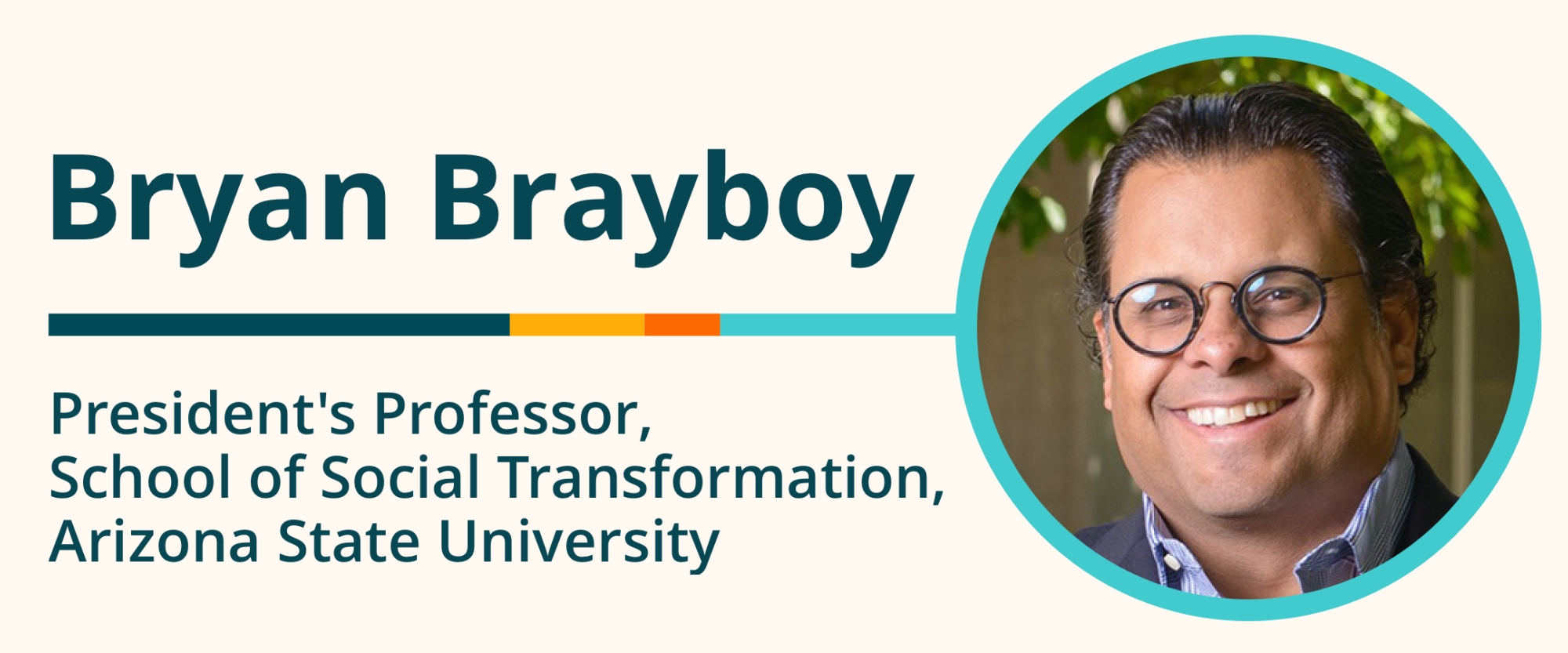We sat down with Dr. Bryan Brayboy, President's Professor in the School of Social Transformation at Arizona State University, for the Scholarship to Practice Podcast. He spoke about challenges that indigenous students face in higher education, the efforts and missteps of institutions in addressing Native populations' needs, and the deep history of rights and responsibilities in U.S. democracy.
The Climate for Indigenous Students in Higher Ed
Dr. Brayboy identified the three biggest misunderstandings related to indigenous students in higher education.
"One is that we exist in college," he began. "I think the perception of our invisibility becomes really important. Another is that Native people in higher ed get free tuition, which isn’t true. Actually the primary barrier for Native students being successful in higher ed is about finances. The other big misunderstanding is that making a transition from a tribal community to a university should be as easy as it is for other groups. I think the transition, the history ends up making it much more complicated."
Part of this complication involves the dark history of boarding schools in North America, chapters of which are still coming to light, and how that impacts on institutions that want to serve Native students in the 21st century.
"I think that folks get caught up in saying, 'Acknowledgment that there was wrongdoing leads to all kinds of other issues,'" Dr. Brayboy observed. "You can’t build relationships with people or communities if you don’t have some honesty. The history’s become really important, because we bring that with us. If I am the child or grandchild of boarding school survivors, a distrust of schools that were really about assimilation and tearing my culture away begins to follow me.
"At the same time, to be an indigenous person in the 21st century requires some of us to have degrees," he noted, "so universities become an important part of our present and future. No one’s saying that the university was complicit in that past abuse, although it may have been. But I think institutions just need to get really clear about talking with tribal peoples and tribal communities. You can’t say, 'Here’s the solution to a problem that I know nothing about.' Bring people in who have an idea about what the problem is, who are actually living it, and then allow them to guide us and move us forward."
Land Acknowledgments
We asked Dr. Brayboy how an institution's well-intended gesture of outreach could miss the mark. He referred to Hayden King of Ryerson University, who did the first land acknowledgment and is now questioning whether he did the right thing.
"Land acknowledgments are when universities say, 'We’re on the ancestral homelands of whatever tribal nation,'" explained Dr. Brayboy. "It creates a couple of issues. One is, for many of us, it feels performative. It happens at the very beginning of a conference or a meeting, or it’s on the website. Then there’s no other mention of indigenous peoples. Issues that are important to us aren’t taken up. I would also say that, when we talk about land, we’re talking about a physical space. Really, this should fundamentally be about place. Land is the physical space. Place is when that land has been imbued with meaning by people. The lands that universities sit on are often thought of differently by indigenous peoples. If we think about land grants and the Morrill Act, are institutions actually paying attention to where their lands come from? There were people on those lands who were removed, often violently.
"What does it mean," he asked, "for institutions to actually do a land acknowledgment, a place acknowledgment that, one, says, 'We recognize this history,' and two, says, 'We’re going to do something about it'? To move from performative to action, those acknowledgments need to then have a plan for the ways in which institutions are going to address the needs of the communities that were once, and may still be, on those lands."
Missing the Mark
Although reluctant to denigrate failed experiments at inclusion, Dr. Brayboy offered us a vivid example of good intentions gone wrong.
"I was formerly a faculty member at the University of Utah – Utah is named after Ute peoples. There was, up on the Bench, Fort Douglas that was put there for the U.S. Army to keep an eye on the Indians and the Mormons. There are Native bodies buried up there, and the American Indian Resource Center was placed on this fort intended to control indigenous peoples. In spite of this concern being raised with the institution, it stayed there. Here’s why that’s a big deal. Students and faculty don’t necessarily want to go to a place, one, where there are bodies buried close by, because there are religious or spiritual reasons for us to not do that; but two, there wasn’t a fundamental recognition of the history of violence by the U.S. Army against these people. Students would unknowingly come into this. They had to go home, have a ceremony. There were added financial costs to that, but also the cost of having someone do the ceremony, and the cost of missing school. What was intended to be a resource for students ended up having the opposite effect."
For those who might be unfamiliar with some of these cultural implications, Dr. Brayboy explained, "For our students, coming in contact with dead bodies or buried bodies that they’re unaware of means that, spiritually, it will impact both their physical and mental health. The ceremonies are intended to purify, cleanse, and get them back in balance with themselves. When we talk about how institutions can be in right relation with tribal communities, we also have to be in right relations with ourselves. For indigenous peoples – not for all, but for some – ceremonies help us create and recreate that equilibrium, so that we are balanced spiritually and emotionally, so that we can be physically well."
Being in Right Relation
At several points in our conversation, Dr. Brayboy used the phrase "to be in right relation." Here's how he defined it:
"If we are in relationship with one another, then we are responsible to each other. It’s the way I think about indigenous knowledge systems and ways of being. I think that for institutions of higher education to be in right relations, if I’m on your land, borrowing from your ways of knowing, borrowing from your resources, then I have a responsibility to you. To be in good relation means I acknowledge that there were peoples here before who were actually brilliant and brought things that I’m borrowing.
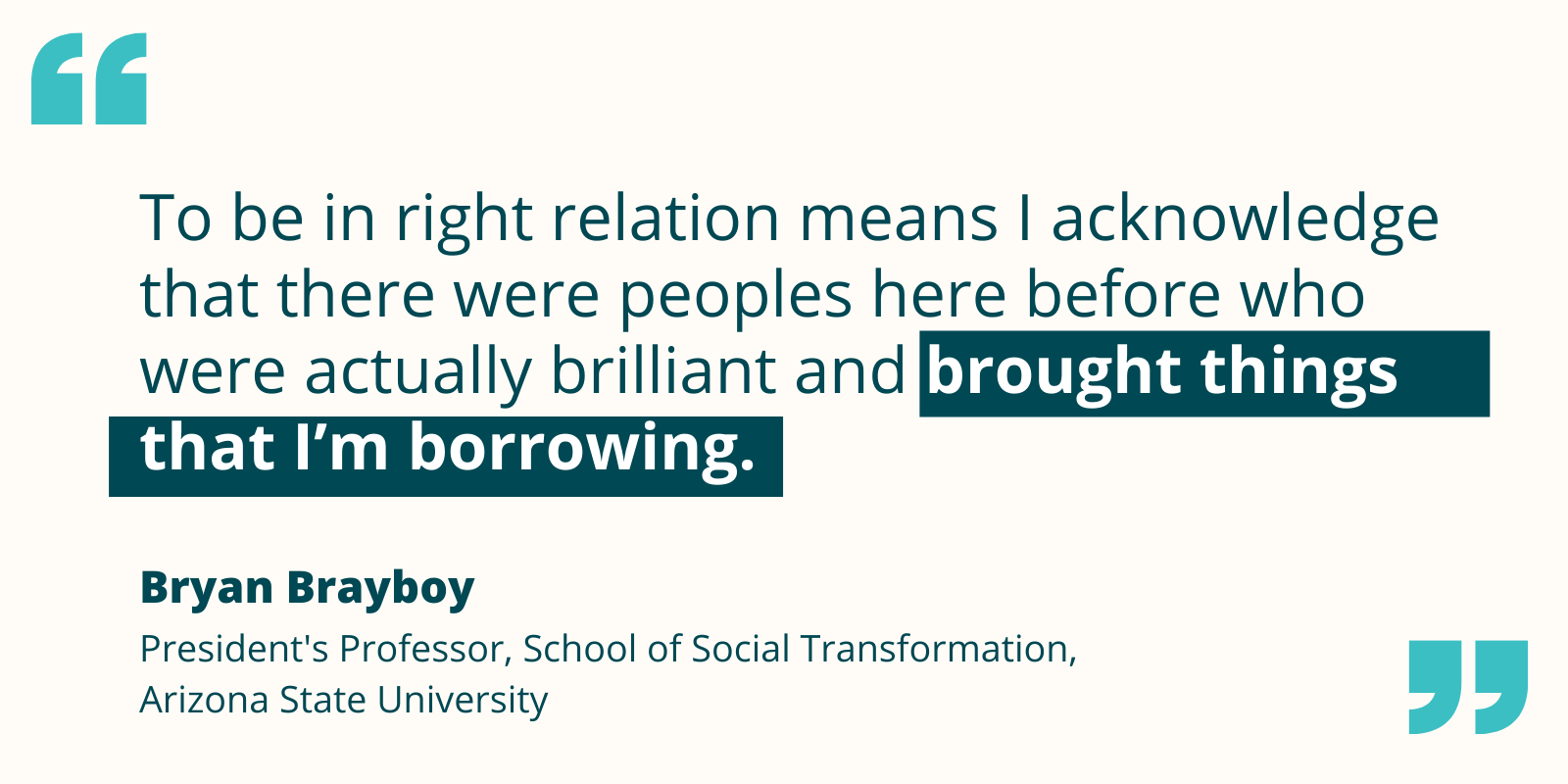
"For land grants," he continued, "to be in good relationship for us means, one, we acknowledge the place that we’re on. Two, we have a plan moving forward to be able to address those folks, to begin to take up a responsibility. Three, we don’t just have a plan, but we’ve consulted with people about what their needs are. We don’t need to go into tribal communities and say, 'Here’s what you need.' Relationships require a level of listening, a level of humility that we actually have something to learn from folks who can say, 'Here’s what my needs are,' and then begin to say, 'OK, here’s what we can do.' We shouldn’t be guiding the conversations as much as we should be bringing our resources to bear to be able to address the needs of communities.
"If this works really well, there’s a level of reciprocity," said Dr. Brayboy. "Our institutions are intended to help people create futures of their own making and have communities create futures of their own making. One way that we do that is by making ourselves more accessible and open to people. Being in right relation means listening. It means being humble. It means stepping up and saying, 'What can I do to help?'"
Rights, Responsibilities, and Democracy
Many Americans are unaware that Native peoples had a profound influence on the way in which the U.S. government was structured. Dr. Brayboy suggested reframing how we teach civics to include this level of awareness.
"There’s really clear evidence that Benjamin Franklin borrowed from Haudenosaunee people – Six Nations, Iroquois Confederacy peoples – about having representatives in the legislature, being guided by courts and other executives," he told us. "I think just knowing that there are indigenous ideals and principles rooted in these founding documents brings indigenous people to the fore, to say there was actually brilliance here before the U.S. started.
"In terms of civics education," he went on, "I think that many people don’t know a lot about how government works and how it’s supposed to work. It’s been recast as some sort of boogeyman out to get us, when in fact we need a structure that helps guide us, and there are policies and processes that are intended to represent people as individuals and people as groups. Fundamentally, that’s what a democracy is supposed to do. I think we need to move toward thinking about the ways in which rights necessarily carry with them levels of responsibility. This conversation about whether or not I would wear a mask to protect others is a really interesting one to me. It’s been framed, in some ways, as an infringement on my rights. What if we thought about what are our responsibilities to be good citizens, and to be in good relation with one another? That changes the conversation when we say, 'I have responsibilities as a person with rights.'"
Note: This interview in the Scholarship to Practice Series originally aired on September 2, 2021 as part of the University Innovation Alliance’s Innovating Together Podcast, appearing live on Facebook, Twitter, and LinkedIn.
Links Mentioned in This Episode
• Dr. Bryan Brayboy
• School of Social Transformation
• Arizona State University
• Boarding schools ("Indian Boarding Schools' Traumatic Legacy, And The Fight To Get Native Ancestors Back" by Sam Yellowhorse Kesler, NPR, 8/28/21)
• Hayden King ("'I Regret It': Hayden King on writing Ryerson University's territorial acknowledgment" adapted from CBC Radio, 1/18/19)
• Morrill Act (Public college land grant legislation of 1862, as documented in the Library of Congress Research Guides)
• Fort Douglas (article from the Utah History Encyclopedia)
• Haudenosaunee (also known as the Iroquois, a confederacy of Native tribes in the Northeastern U.S.)
Keeping Up With Dr. Bryan Brayboy
You can find Dr. Brayboy on Twitter @BryanBrayboy or reach him via email at Bryan.Brayboy@asu.edu.
Bios of Guest Luminary and Co-Hosts
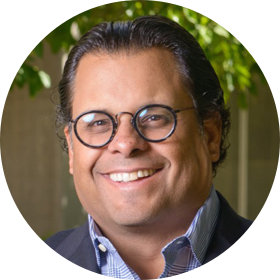
Guest Luminary: Bryan Brayboy, President's Professor, School of Social Transformation, Arizona State University
Dr. Bryan McKinley Jones Brayboy (Lumbee) is President’s Professor in the School of Social Transformation at Arizona State University. He is senior advisor to the president, director of the Center for Indian Education, and co-editor of the Journal of American Indian Education. From 2007 to 2012, he was visiting President’s Professor of Indigenous Education at the University of Alaska Fairbanks. Dr. Brayboy is the author of more than 95 scholarly documents, including contributions to eight volumes, dozens of articles and book chapters, multiple policy briefs for the U.S. Department of Education, National Science Foundation, and the National Academy of Sciences. His research focuses on the role of race and diversity in higher education, and the experiences of Indigenous students, staff, and faculty. He is a fellow of the American Educational Research Association, a member of the National Academy of Education, and has been a visiting and noted scholar in Canada, Australia, New Zealand, and Norway. His work has been supported by the U.S. Department of Education, the National Science Foundation, the Ford, Mellon, Kellogg, and Spencer Foundations, and several other private and public foundations and organizations. Over the past 17 years, Dr. Brayboy and his team have prepared over 165 Native teachers to work in American Indian communities and more than 21 American Indian Ph.D.s.
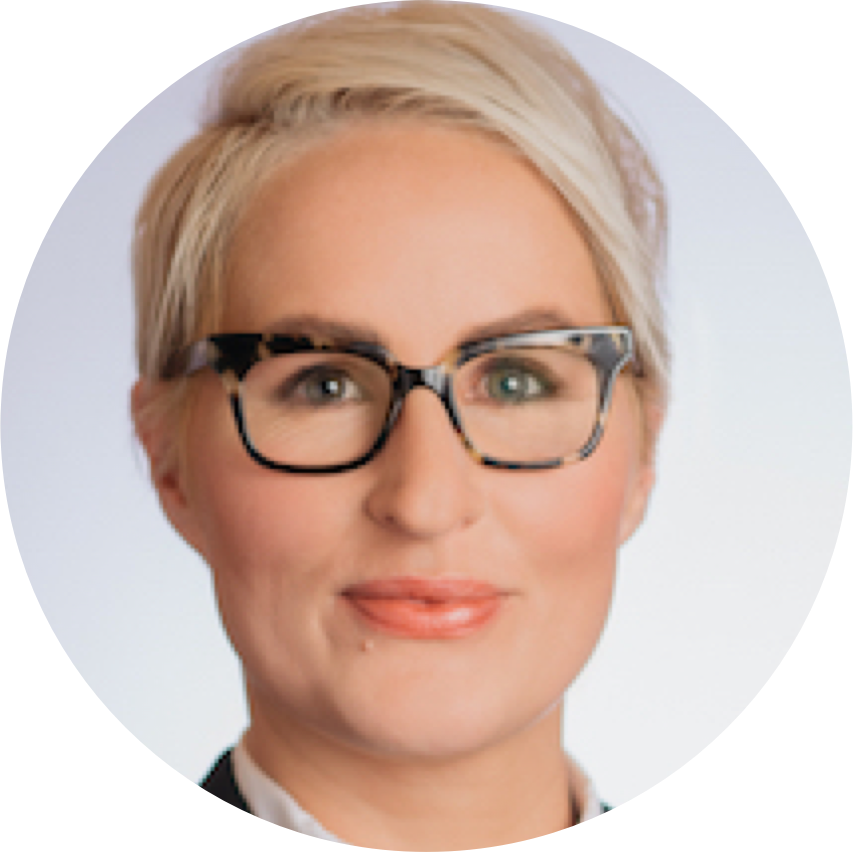
Co-Host: Bridget Burns, Executive Director, University Innovation Alliance
Dr. Bridget Burns is the founding Executive Director of the University Innovation Alliance (UIA). For the past decade, she has advised university presidents, system chancellors, and state and federal policy leaders on strategies to expand access to higher education, address costs, and promote completion for students of all backgrounds. The UIA was developed during Bridget’s tenure as an American Council on Education (ACE) Fellowship at Arizona State University. She held multiple roles within the Oregon University System, including serving as Chief of Staff and Senior Policy Advisor, where she won the national award for innovation in higher education government relations. She was a National Associate for the National Center for Public Policy and Higher Education, and has served on several statewide governing boards including ones governing higher education institutions, financial aid policy, and policy areas impacting children and families.
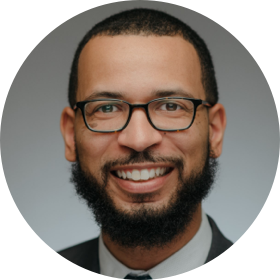
Co-Host: Derrick Tillman-Kelly, Director, University Innovation Alliance Fellows Program and Network Engagement
Dr. Derrick L. Tillman-Kelly serves as the Director of the UIA Fellows Program and Network Engagement for the University Innovation Alliance. He previously served in multiple roles at The Ohio State University, including as the inaugural UIA Fellow and special assistant to the director of the Center for Higher Education Enterprise. Dr. Tillman-Kelly earned his Ph.D. in educational policy and leadership with a specialization in higher education and student affairs from Ohio State; a master’s degree in higher education and student affairs from Indiana University; and a bachelor’s degree from Illinois Wesleyan University.
About Scholarship to Practice
Scholarship to Practice is an event series that happens live on Facebook, Twitter, and LinkedIn. It also becomes a podcast episode. We interview higher education scholars, researchers, and academics as we surface relevant research on topics that administrators often wonder about, and examine how a practitioner or administrator could apply this learning in real-time to improve student success. At the UIA, we know that we need to bridge that gap between scholarship and practice if we’re going to stand a chance of improving student success. We all need to work together leveraging research in the field and identifying where we need more research to support greater innovation in higher ed. With its short and conversational format, this show is designed to help bridge that gap by elevating the relevant research we all could be using in our daily lives.
Rate, Review & Subscribe
Learn why hundreds of people have rated this new podcast 5 stars! Please join others and rate and review this podcast. This helps us reach and inform more people -- like you -- to help increase the number and diversity of college graduates in the United States.
Click here, scroll to the bottom, tap to rate with five stars, and select “Write a Review.” Then be sure to let us know what you loved most about the episode! Also, if you haven’t done so already, subscribe to the podcast. We’ll be adding a bunch of bonus episodes to the feed and, if you’re not subscribed, there’s a good chance you’ll miss out.

